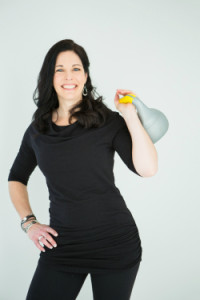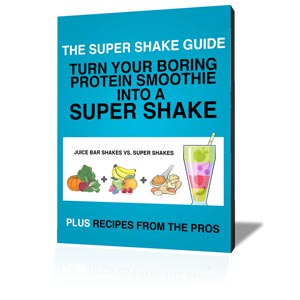Tamara and I have never meant in person yet I feel like I know her so well. Between her no nonsense blogging, Periscope chats for mid-life chicks and open and honest Facebook posts, it feels like we talk on a a regular basis. If you do visit her blog, FitKnitChick, you’ll also find out how strong she is, both inside and out. I am proud to call her my friend and grateful for her willingness to share knowledge as well as her personal struggles. – Pamela
There’s nothing like peri-menopause to wreak havoc on a perfectly good fitness and nutrition routine.
Many long-time regular exercisers swear that the minute they hit their 40’s the workout schedule and nutrition plan they’d been following for years stopped working. Common complaints include weight gain (hello ‘menopot’), loss of muscle mass, reduced energy, out-of-control sugar cravings, increased frequency of injury and loss of flexibility.
Most of these symptoms are related to the changing hormones of peri-menopause; the 5 to 10 year period of hormonal fluctuation leading up to the cessation of menses. Estrogen, progesterone and testosterone all typically begin to decline during the early 40’s. They do so in an often erratic way, leading to hormonal imbalances that affect a woman’s body and how it burns, stores and uses calories.
As a consequence, fitness and nutrition routines that previously ‘worked’ to facilitate weight loss and muscle gain, often stop working. Many women respond by upping their efforts in the gym and reducing their food intake. Alas, the ‘exercise more, eat less’ approach rarely works and often results in additional weight gain (not to mention injury). Others give up entirely, frustrated, discouraged and blaming themselves for being unable to turn things around.
The trick to mitigating menopausal symptoms and reversing hormonal weight gain? Understanding and manipulating metabolic mechanisms to your advantage! In effect, working smarter, not harder, both in the gym and in the kitchen.
5 ways your fitness routine needs to change during peri-menopause:
Make strength training a priority
From about age 35 onwards, our bodies start to lose lean tissue. Organs (including your liver and kidneys) lose cells and muscles begin to shrink (or ‘atrophy’). Because muscle is metabolically active (meaning that it burns calories, even at rest), reduced muscle mass often results in a reduced metabolic rate. Building muscle will increase your body’s ability to burn calories, improve your ability to perform activities of daily living and change the way your clothes fit. Note that depending on your testosterone levels, it may be more challenging to build muscle than it was it your 20’s and 30’s. At least there’s no worry about ‘bulking up’. 😉
Try adding two to three days of whole-body strength training to your routine. Focus on ‘old-school’ exercises including pushups, weighted squats and dead lifts, shoulder presses and bent-over rows. Two to three sets of 8 to 10 good form reps of everything, with weights that are challenging but not so heavy as to leave you completely ‘tanked’ at the end of your workout.
Re-evaluate your approach to cardio
Cardiovascular training is important for the maintenance of a healthy heart and lungs. For many women, it’s also the exercise of choice when attempting to lose or maintain weight. Many women begin training for their first half-marathon in their 40’s, thinking it will be the answer to their midlife weight gain woes.
While there will be some women who find success with this approach (hint, it’s usually because they already possess a runner’s physique…), many more will notice that despite increasing their weekly mileage, the pounds aren’t coming off and their body actually appears softer and less shapely than before. This is because long, slow distance cardio can be stressful on the body, elevating cortisol levels and depending on what and how much they’re eating, catabolize precious muscle mass.
Two types of cardio have been shown to have beneficial effects on midlife weight gain; short bouts of high intensity effort (HIIT or High Intensity Interval Training) and longer, lower intensity, leisurely walks (the latter of which are also wonderful for reducing cortisol and it’s effects on your midsection). Again, working smarter, not necessarily harder.
Try reducing your long slow distance training to once or twice each week, adding in a day or two of HIIT cardio (as little as 10 minutes at the end of a strength training workout) and near-daily leisurely walks.
Ensure adequate rest and recovery between workouts
Middle-aged bodies are both more susceptible to injury (knees, hips and shoulders, in particular) and take longer to recover from sprains and strains than they used to. Reduce your risk of injury and subsequent lengthy breaks from exercise by ensuring that your body is completely recovered from your last strength workout before you hit the gym again. For whole-body strength workouts, this might mean following an every 2nd or 3rd day workout plan.
And don’t forget about sleep. That’s when much of the muscle rebuilding and recovery takes place. Studies have shown that people who are chronically sleep-deprived (fewer than 6 hours of sleep per night) have more difficulty losing weight and maintaining weight loss than those who get to bed early and stay there until morning. An extra challenge for peri-menopausal women whose symptoms include sleep disruption…
Don’t leave sprains and strains to heal on their own. If they’re interfering with exercise and daily activities after a day or two, get yourself to a professional. Often times an improperly healed injury will result in dysfunctional movement or injury elsewhere in the body. You don’t have time for that.
Spend more time stretching
Just like muscle mass, flexibility also tends to decline with age. Maintaining flexibility as we get older is important, not just for ease of movement and the ability to continue participating in all the activities we love, but also because it allows us to avoid trips and falls that might lead to more serious injuries.
Make time for stretching at the end of every workout. Incorporate stretches for each major muscle group (chest, back, hips, quads, calves and hamstrings). Stretch to the point of slight resistance, never pain, and hold for 30 to 60 s. Remember to breathe and resist the tendency to bounce.
Yin and restorative yoga are wonderful additions to your midlife fitness routine. Not only will they increase your flexibility, you’ll also benefit from the calming and meditative effects on your brain. Yet another way to reduce cortisol production and middle-of-the-body weight gain.
Recognize the value of consistency
Unlike in our younger years, midlife fitness gains tend to reverse themselves fairly quickly when we take a break from exercise. Not to mention how much more challenging it is to start a new program than to just stick with the one you’re currently on.
More than ever, consistency is your best friend when it comes to exercise. Find a friend or group of like-minded women for support, encouragement and accountability. Remind yourself how great you feel when you’re exercising regularly and all the positive changes to your life fitness has given you.
Then wake up and do it all over again tomorrow.
Tamara Grand is a Certified Personal Trainer and Online Fitness Coach who’s passionate about helping midlife women become the fittest, healthiest and happiest version of themselves possible. She runs a monthly online coaching program for 40+ women that’s always has space for new positive, motivated and community-minded women. You can find details about her services, as well as essays about exercise, nutrition and mindset at https://fitknitchick.com.




